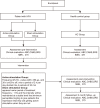Effects of transcutaneous auricular vagus nerve stimulation and exploration of brain network mechanisms in children with high-functioning autism spectrum disorder: study protocol for a randomized controlled trial
- PMID: 38374975
- PMCID: PMC10875019
- DOI: 10.3389/fpsyt.2024.1337101
Effects of transcutaneous auricular vagus nerve stimulation and exploration of brain network mechanisms in children with high-functioning autism spectrum disorder: study protocol for a randomized controlled trial
Abstract
Background: Autism Spectrum Disorders (ASD) are a collection of neurodevelopmental diseases characterized by poor social interaction and communication, a limited range of interests, and stereotyped behavior. High-functioning autism (HFA) indicates a subgroup of individuals with autism who possess cognitive and/or language skills that are within the average to above-normal range for their age. Transcutaneous auricular vagus nerve stimulation (taVNS) holds promise in children with HFA. However, few studies have used randomized controlled trials to validate the effectiveness of taVNS. Therefore, in this study, we intend to provide a study protocol to examine the therapeutic effects of taVNS in individuals diagnosed with HFA and to investigate the process of brain network remodeling in individuals with ASD using functional imaging techniques to observe alterations in large-scale neural networks.
Methods and design: We planned to employ a randomized, double-blind experimental design, including 40 children receiving sham stimulation and 40 children receiving real stimulation. We will assess clinical scales and perform functional imaging examinations before and after the stimulation. Additionally, we will include age- and gender-matched healthy children as controls and conduct functional imaging examinations. We plan first to observe the therapeutic effects of taVNS. Furthermore, we will observe the impact of taVNS stimulation on the brain network.
Discussion: taVNS was a low-risk, easy-to-administer, low-cost, and portable option to modulate the vagus system. taVNS may improve the social performance of HFA. Changes in the network properties of the large-scale brain network may be related to the efficacy of taVNS.
Clinical trial registration: http://www.chictr.org.cn, identifier ChiCTR2300074035.
Keywords: high-functioning autism; neuromodulation; protocol; randomized control trial; transcutaneous auricular vagus nerve stimulation.
Copyright © 2024 Sun, Li, Zhai, Yin, Liang, Zhai, Cui and Zhang.
Conflict of interest statement
The authors declare that the research was conducted without any commercial or financial relationships that could be construed as a potential conflict of interest.
Figures


Similar articles
-
The efficacy and safety of transcutaneous auricular vagus nerve stimulation for patients with minimally conscious state: a sham-controlled randomized double-blind clinical trial.Front Neurosci. 2023 Dec 14;17:1323079. doi: 10.3389/fnins.2023.1323079. eCollection 2023. Front Neurosci. 2023. PMID: 38156271 Free PMC article.
-
The efficacy and safety of transcutaneous auricular vagus nerve stimulation in patients with mild cognitive impairment: A double blinded randomized clinical trial.Brain Stimul. 2022 Nov-Dec;15(6):1405-1414. doi: 10.1016/j.brs.2022.09.003. Epub 2022 Sep 21. Brain Stimul. 2022. PMID: 36150665 Clinical Trial.
-
Optimizing the modulation paradigm of transcutaneous auricular vagus nerve stimulation in patients with disorders of consciousness: A prospective exploratory pilot study protocol.Front Neurosci. 2023 Mar 15;17:1145699. doi: 10.3389/fnins.2023.1145699. eCollection 2023. Front Neurosci. 2023. PMID: 37008222 Free PMC article.
-
Therapeutic applications of transcutaneous auricular vagus nerve stimulation with potential for application in neurodevelopmental or other pediatric disorders.Front Endocrinol (Lausanne). 2022 Oct 12;13:1000758. doi: 10.3389/fendo.2022.1000758. eCollection 2022. Front Endocrinol (Lausanne). 2022. PMID: 36313768 Free PMC article. Review.
-
Transcutaneous auricular vagus nerve stimulators: a review of past, present, and future devices.Expert Rev Med Devices. 2022 Jan;19(1):43-61. doi: 10.1080/17434440.2022.2020095. Epub 2022 Jan 13. Expert Rev Med Devices. 2022. PMID: 34937487 Review.
Cited by
-
tVNS alters inflammatory response in adult VPA-induced mouse model of autism: evidence for sexual dimorphism.FEBS Open Bio. 2025 Jan;15(1):69-80. doi: 10.1002/2211-5463.13889. Epub 2024 Oct 14. FEBS Open Bio. 2025. PMID: 39401991 Free PMC article.
References
-
- American Psychiatric Association . Diagnostic and Statistical Manual of Mental Disorders (DSM-5). 5th edn. Washington, DC: American Psychiatric Association Publishing; (2013).
-
- Maenner MJ, Warren Z, Williams AR, Amoakohene E, Bakian AV, Bilder DA, et al. . Prevalence and characteristics of autism spectrum disorder among children aged 8 years - autism and developmental disabilities monitoring network, 11 sites, United States, 2020. MMWR Surveill Summ (2023) 72(2):1–14. doi: 10.15585/mmwr.ss7202a1 - DOI - PMC - PubMed
LinkOut - more resources
Full Text Sources

